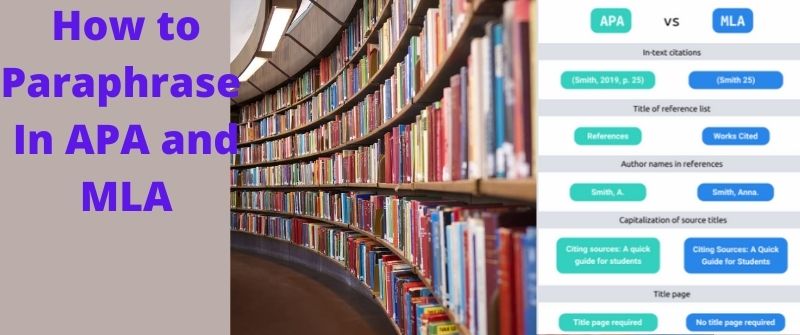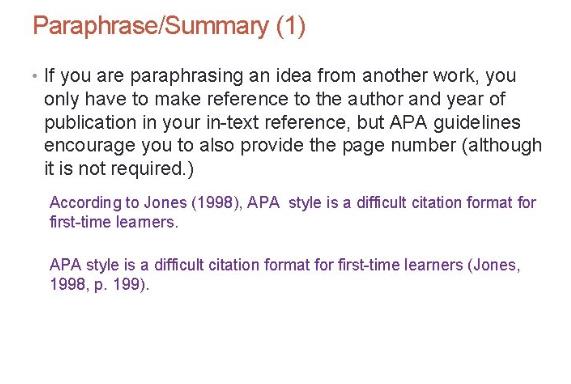How to Paraphrase in APA and MLA: Full Guide to Scoring High

When writing an academic paper using either APA or MLA formats, you are required to produce plagiarism-free content. This is because it is an academic crime to plagiarize another writer’s work and present it as your own. To avoid plagiarism in academic writing, one of the best methods used is paraphrasing.
Paraphrasing can be regarded as the act of rewriting or restating the meaning of the original passage or text using your own words.
When researching for your academic papers, you will find and include information and ideas collected from the sources in your paper. You are required to put the ideas or information in your own words to avoid plagiarism.
Paraphrasing in either APA or MLA formats takes different forms. This essay will provide you with detailed descriptions of how you are supposed to paraphrase original texts using the two academic writing formats.
If you need such services, check our essay paraphrasing service and get yourself a new paper from a rather old one.
Need Help with your Homework or Essays?
How to Paraphrase in APA
The APA format is among the most commonly used writing formats in academic writing.

There is a great chance that your instructor has required you to write essays or research papers using this format.
As such, it is important to learn how to paraphrase appropriately using the format to impress the instructor and get good grades.
1. Read and Understand the Source
Reading and understanding the source of information is the first step you need to take before paraphrasing any text.
This not only applies to the APA format but other academic writing formats too and other forms of writing. You simply cannot rewrite something in your own words in such a way that you retain the original meaning if you have not read and understood the text.
When you have fully understood the original text, its meaning, and the points it intends to pass to the reader, then you can rewrite it into your APA formatted paper or essay.
2. Identify the Main Points
After you have read the text and understood its meaning, you should identify the main points and any information that supports the points. This narrows down your scope in such a way that you will not have to rewrite everything.
You will only need to identify the main points that relate to the claims in your APA formatted paper and the supporting information that you will paraphrase.
Rewriting or paraphrasing everything from the original text would not make sense because not everything is important for your paper.
Not everything from the source will effectively and appropriately support your claims. Therefore, identify the main points and the supporting information.
3. Rewriting
The next step in paraphrasing using APA format is to rewrite the selected portions of the original text in your own words. It is very important to avoid the usage of similar sentence structure or phrasing because your paper will be flagged by plagiarism-checking tools.
4. Use of Lead-ins
When rewriting or paraphrasing the original text, you can use lead-ins to signal to the readers that you are about to paraphrase what another person has said. Such lead-ins can include “according to…”, “as the author(s) state…”, “as the text/book/journal/article notes…”
Once you are done with the aforementioned steps, you should compare the paraphrased text with the original text. Make sure that your new text conveys the same meaning as the original text. Furthermore, the phrasing and the sentence structure should not be similar.
5. Including a Citation
This is the most important step when paraphrasing using the APA format. When you paraphrase any text, you should make sure that the author of the original text or the source of your information has been given credit using an in-text citation.
Here, you are required to provide the author’s surname and the year they published their work. It should be enclosed in brackets, for example (Jonathan, 2021).
Citing Quotes, Paraphrases, and Summaries in APA
As aforementioned, citing is very important when you use another writer’s ideas or work in your paper. You should format the citations using the appropriate APA style, in this case, the 7th edition.

When quoting, you only need to copy-paste the original text into your paper.
Once you have done that, enclose the text using quotation marks (“…”) and italicize it.
On the other hand, when you are summarizing the original text, you only need to express the main points in your paper.
Whether paraphrasing, quoting, or summarizing the original text, you are required to appropriately cite the source using the proper APA format at the end of the text.
Citing paraphrases, quotes, or summaries in APA is standard. You only need to state the author’s surname the year their work was published, and enclose them using brackets.
For example, if you have quoted, summarized, or paraphrased an author called Jonathan, who published their work in 2025, the citation at the end of the sentence should be (Jonathan, 2021). Ensure that you separate the author and the year using a comma.
Citing two authors should appear like this: (Jonathan & Mark, 2021). When three or more authors have written a source, include the surname of the first author and add an “et al.” to it. It would look like this: (Jonathan et al., 2021).
How to Cite Paraphrased Information in APA from a Website, Book, and News
When citing paraphrased information from a website, you should include the author of the information and the year they posted the information on the website.
If the author’s name is not given, write the name of the website instead. If the date is not provided, use “n.d.”, which means “no date” provided”. Format it as aforementioned.
Concerning a book, you should include the author’s surname and the year the book was published, just as described above. When it comes to news, you should provide the name of the news network followed by the date it was broadcast.
How to Paraphrase in MLA
Paraphrasing in MLA takes the same strategy as in APA. You only need to read and understand the source of the information, take note of the main points and their supporting arguments that will help you in your paper, and rewrite the source of information in your own words.
You should also make sure that the phrasing and sentence structure are not similar to the original text because your work will be plagiarized.
Furthermore, make sure that you properly or appropriately cite the source of the information using MLA format. This is where the big difference between APA and MLA comes in in this case. The structure of the citations is different; hence, you should be very careful.
Get a Brilliant Essay today!
Let our essay writing experts help you get that A in your next essay. Place your order today, and you will enjoy the benefits.
How to Cite Quotes in MLA
As noted within the APA section within this article, when quoting, you only need to copy-paste the original text into your paper. Once you have done that, enclose the text using quotation marks (“…”) and italicize it. This is similar across the board because there is no other way of quoting text in your academic papers.

However, the difference is in citations.
MLA citations or in-text citations require you to include the author’s surname followed by the page number of the source of your information.
Note that you are not required to provide the year but the page number after the author’s surname.
The surname and the page number are not separated by a comma. They are only separated by a space.
For example, if Mark Jonathan wrote a paper and you want to quote some information from page 11 of the paper, then your MLA citation will look like this: (Jonathan 11). This should immediately follow the quote to ensure that you have not plagiarized the quote.
If you have two authors, your MLA citation should appear like this: (Jonathan & Martin 11). Note that there is still no comma used to separate the authors and the page number.
If the authors are three and above, your citation should appear like this: (Jonathan et al. 11). You should also note that there is no comma in this case. Only a space separates “et al.” and the page number.
How to Cite Paraphrasing in MLA
Paraphrasing in MLA is similar to how you paraphrase in APA because paraphrasing takes a similar strategy. You only need to rewrite the information in your own words in such a way that it retains the same meaning and points.
Use the same strategy mentioned above to formulate the citation at the end of the paraphrase. As we explained in our other guide, if done well, paraphrasing is not plagiarism, it can help get you over the line when writing essays.
How to Cite Summarizing in MLA
As noted, summarizing is writing the main points of the original text. Once you write the summary, ensure that you cite it using the appropriate MLA format, as noted above.
How to cite paraphrased information in MLA from a website, book, and news
When you have appropriately paraphrased information from a website, ensure that you include the surname of the author followed by the page of the web window. This is because some articles can have several pages where you are asked to click an arrow to access the next page.
However, on most websites, the information is on the first page; hence, you will only write “1” as the page number. It will look like this: (Jonathan 1). If the author’s name is absent, provide the website’s name.
When it comes to a book, you need to provide the author’s surname and the page number. Concerning news sources, you should provide the name of the news article and the page number of the information.

Josh Jasen or JJ as we fondly call him, is a senior academic editor at Grade Bees in charge of the writing department. When not managing complex essays and academic writing tasks, Josh is busy advising students on how to pass assignments. In his spare time, he loves playing football or walking with his dog around the park.




